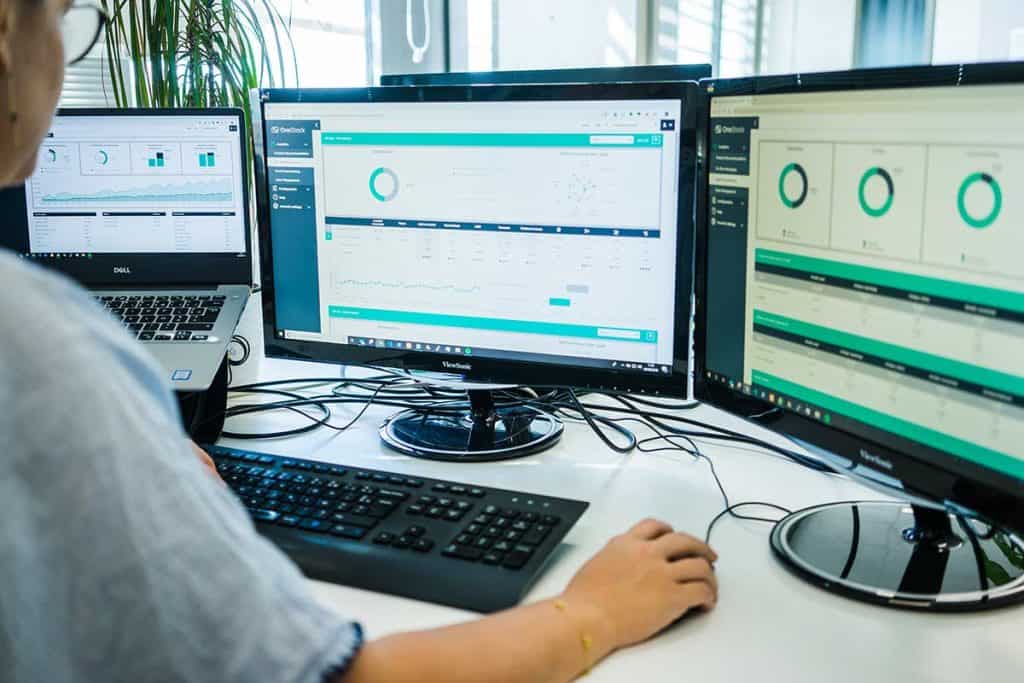
Introduction to Stock Management Systems: A Comprehensive Guide
Efficient stock management is crucial for the success and sustainability of any organisation dealing with physical goods. Whether you operate in a retail, e-commerce or B2B environment, you’ll already understand the importance of maintaining optimal inventory levels, reducing costs and meeting customer demands. This is where Stock Management Systems can help you gain a competitive advantage.
In this comprehensive guide, we’ll explore how a Stock Management System can completely revolutionise your operations, with guidance to help you implement the technology and systems you need to optimise inventory management, maximise profit margins and future-proof your business.
Table of contents
1. What is a Stock Management System?
i. Definition and basic functions
ii. Why businesses use Stock Management Systems
iii. Common tools and software
2. Benefits of a Stock Management System
i. Improving inventory accuracy
ii. Reducing costs and waste
iii. Enhancing customer satisfaction
3. Implementing a Stock Management System
i. Selecting the right system
ii. Integration with existing tools
iii. Training and support
4. Advanced features and technologies
i. AI and machine learning in stock management
ii. Integration with ERP and other systems
iii. Real-time tracking and analytics
5. Challenges and solutions in stock and order management
i. Overcoming implementation barriers
ii. Addressing security and compliance issues
iii. Best practices for scalability
6. Final thoughts on Stock Management Systems: a path forward
i. Essential considerations for success
ii. Staying ahead with continuous learning
iii. Next steps and resources
1. What is a Stock Management System?
Definition and basic functions
A Stock Management System, or Order Management System (OMS), is a software solution designed to efficiently track, manage, and optimise a company’s inventory.
At its core, an OMS helps businesses keep a real-time record of all their products, with critical data on stock levels, movements and availability. This allows businesses to make informed decisions about purchasing, production, order processing and distribution to meet customer demands while optimising inventory-related costs.
Key functions of a Stock Management System include:
- Inventory visibility and tracking: An OMS maintains a real-time record of stock inventory, tracking quantities, locations and item statuses. This granular visibility helps businesses make informed decisions about restocking, reordering and allocation.
- Order orchestration: Powerful algorithms automatically allocate the relevant stock to a customer order considering factors such as stock location, delivery address, environmental impact or transportation costs.
Why businesses use Stock Management Systems
Businesses turn to Stock Management Systems for several compelling reasons.
- An OMS provides real-time visibility into inventory levels, minimising discrepancies and errors. This ensures businesses can fulfil customer orders accurately and on time.
- Efficient stock management leads to reduced carrying costs, lower storage expenses and minimised wastage due to expiration or obsolescence. Businesses can allocate resources more effectively.
- By ensuring products are consistently available when customers need them, an OMS contributes to faster order fulfilment and improved customer satisfaction.
- As businesses grow, their stock management needs evolve. An OMS offers scalability, adapting to changing demands without disrupting operations.
Common tools and software
There are various tools and software solutions available for stock management, from general Enterprise Resource Planning (ERP) solutions to specialised Order Management Systems (OMS), each catering to specific needs. Some commonly used stock management tools include:
- Barcode scanners and RFID technology: These hardware solutions enable accurate and efficient inventory tracking.
- Point of Sale (POS) Systems: Retail solutions that integrate inventory tracking with sales transactions.
- ERP Systems: Enterprise-level solutions that integrate stock management with other business functions like finance, sales and human resources.
- Order Management Systems: Dedicated applications that offer more sophisticated stock and order management features like real-time tracking, demand forecasting and reporting. A cloud-based OMS offers additional benefits in terms of scalability, accessibility and automatic updates.
A spotlight on OneStock’s order management solutions that are tailored to help businesses optimise inventory management, order fulfilment and customer satisfaction. Some key features and benefits include:
- Omnichannel inventory visibility: OneStock enables businesses to have a real-time view of inventory across multiple channels, including physical stores, e-commerce and warehouses. This allows for more accurate order promising and allocation.
- Order orchestration: The system intelligently routes orders to the most efficient fulfilment location, minimising shipping costs and delivery times.
- Advanced omnichannel modules: Additional capabilities to optimise fulfilment processes and elevate the customer experience include Delivery Promise, Order in Store, Ship from Store, Click & Collect and more.
These solutions help businesses to stay competitive in today’s dynamic market, adapt to changing customer expectations and ensure the seamless flow of products from order placement to delivery.

2. Benefits of a Stock Management System
Improving inventory accuracy
Inventory accuracy is now mandatory for any business. The slightest discrepancy in stock levels can result in costly errors, such as overstocking or stockouts. A Stock Management System provides real-time visibility into inventory quantities and locations. This means businesses can monitor stock levels with precision, reducing the likelihood of costly inaccuracies.
- Minimising stockouts: Stockouts are a nightmare for both retailers and customers. When a product isn’t available when a customer wants it, not only does it result in lost sales, but it can also harm a brand’s reputation. An OMS solution tackles this issue head-on by ensuring that businesses have the right products in stock when customers come calling. By optimising stock flow and offering real-time tracking, businesses can dramatically reduce the risk of stockouts.
- Lowering transportation costs: Inefficient inventory management can lead to increased transportation costs. Distributed order management allows businesses to fine-tune their inventory levels, choosing the right place to fulfil orders while saving money, reducing the need for excessive storage space and minimising carrying costs. This optimisation translates into direct cost savings.
Reducing costs and waste
One of the primary benefits of a Stock Management System is its ability to streamline order processes. With historical data and predictive analytics at their disposal, businesses can make informed decisions about stock optimisation. This not only reduces the risk of overstocking but also helps businesses avoid last-minute rush orders that come with premium shipping costs.
- Minimising waste: Waste erodes profits. A well-implemented OMS minimises it by ensuring that items are sold or used before they become unsellable. By maintaining accurate records of inventory age and product shelf life, businesses can significantly cut down on wastage and its associated costs.
- Efficient resource allocation: By optimising inventory management, an OMS allows businesses to allocate stock more efficiently. This leads to reduced carrying costs and a streamlined supply chain.
Enhancing customer satisfaction
In today’s fast-paced world, customers expect speedy order fulfilment. A Stock Management System enables businesses to meet these expectations by ensuring that products are readily available for order processing. This leads to shorter lead times and quicker deliveries, ultimately enhancing customer satisfaction.
- Accurate order fulfilment: Customer satisfaction hinges on receiving the correct products in good condition. An OMS helps businesses fulfil orders accurately by asking for several scans or validations during the fulfilment process. When customers know they can trust a business to deliver what they’ve ordered, their confidence in shopping with that business in the future increases.
- Personalised shopping experiences: An OMS can take customer satisfaction to the next level by enabling businesses to offer personalised shopping experiences through omnichannel services such as in-store appointments, clienteling and proactive order alerts.
3. Implementing a Stock Management System
Implementing a Stock Management System is a pivotal decision for businesses looking to streamline their inventory management processes, enhance efficiency and ultimately boost profitability.
Selecting the right OMS
Choosing the right stock management solution begins with a deep understanding of your business needs. Different industries and businesses have unique requirements. The OMS landscape recognises this diversity with vendors offering solutions designed to address specific industry challenges. By identifying your precise needs, you can narrow down your options and select a system that aligns with your objectives.
Your OMS should be scalable to accommodate your company’s growth and evolve as your business needs and objectives change. This adaptability reduces the risk of outgrowing your solution and needing costly replacements.
Compatibility with existing tools and systems is also crucial for a smooth implementation process. MACH-certified solutions are built with robust integration capabilities, enabling seamless connections with various software applications, including point of sale (POS) systems, e-commerce platforms and accounting software. This ensures that your OMS becomes an integrated part of your business operations.
Integration with existing tools
An OMS must offer real-time data exchange capabilities. This means that as changes occur in your inventory, such as stock levels or order status updates, these changes are instantly reflected across all integrated systems. Real-time data exchange reduces manual data entry and enhances data accuracy.
Integration isn’t just about internal efficiencies – it also impacts the customer experience. Integrated solutions enable businesses to offer services like express Click & Collect or Ship from Store, specifically designed to improve customer convenience and satisfaction.
Training and support
Implementing an OMS requires proper training to ensure that your team can fully leverage its capabilities. Your chosen OMS provider should provide comprehensive training sessions to educate your staff on system functionality, best practices and troubleshooting. A well-trained team can maximise the benefits of your OMS.
Moreover, effective support is essential for addressing any issues that may arise during and after implementation. For this reason, OneStock offers reliable customer support to assist with system maintenance and updates. As technology evolves and businesses grow, continuous learning becomes a competitive advantage. OneStock encourages continuous learning among its clients, providing resources such as User Clubs, documentation and updates to keep businesses informed about the latest developments in stock management.
Ensure your OMS provider is committed to the long-term success of your business.

4. Advanced features and technologies
In the dynamic world of stock management, businesses must continually innovate their operations to stay ahead of the curve and deliver exceptional customer experiences. A number of proven technologies exist that are redefining the landscape of stock management:
AI and machine learning in stock management
Integrating the power of data and machine learning into Stock Management Systems can revolutionise the way businesses optimise efficiency and forecast demand. For example, OneStock’s Business Intelligence (BI) Suite allows an organisation to access historical data, order fulfilment details and various influencing factors to optimise inventory levels, and respond proactively to changing market conditions.
Integration with ERP and other systems
Your OMS should seamlessly integrate with Enterprise Resource Planning (ERP) systems and other critical tools within your business tech stack, such as CRM and PIM solutions. This ensures a smooth flow of data between different departments, enhancing visibility and collaboration.
ERP integration is particularly important for businesses seeking to align financial and operational data. Synchronisation between financial transactions and inventory management will provide a holistic view of business performance.
Real-time tracking and analytics
Real-time tracking capabilities provide businesses with enhanced visibility into their inventory across multiple channels, including physical stores, e-commerce platforms and warehouses. Real-time tracking ensures that businesses can monitor stock levels, order status and location accuracy instantly.
In addition, analytics tools empower businesses to make data-driven decisions. By analysing historical and real-time data, an OMS generates insights into inventory performance, sales trends and demand forecasting. These insights guide strategic decision-making and enable businesses to proactively adapt to market shifts, demand spikes and supply chain disruptions.
5. Challenges and solutions in stock and order management
Stock management is a critical aspect of running a successful business, regardless of the industry you’re in. However, this seemingly straightforward task can pose various challenges.
Overcoming implementation barriers
Implementing a Stock Management System can be a daunting task, especially for businesses with intricate supply chains or multiple locations. Experienced OMS providers will be familiar with the complexities involved in the implementation process for multiple sectors, and will be able offer expert guidance and support to ensure a smooth transition.
Change can sometimes be met with resistance from employees who are accustomed to existing workflows. Implement a change management plan to prepare employees for the transition and address their concerns early in the process. Provide training, documentation and ongoing assistance to help teams adapt to the new system.
Addressing security and compliance issues
Data security is a top priority in stock management, as it involves sensitive information about inventory levels, customer data and financial transactions. Stock Management Systems employ security measures to protect this sensitive data, including regular security audits and compliance checks.
Different industries have specific regulations and compliance requirements related to inventory management. Failing to comply with these regulations can lead to legal and financial repercussions. Ensure your OMS includes compliance features that cater to your industry standards, so you can maintain a transparent and compliant stock management process.
Best practices for scalability
Stock Management Systems must be able to scale accordingly, adapting to changing demands without major disruptions. With the right solution, businesses can expand their operations, open new locations, or enter new markets with confidence, knowing that their OMS can accommodate growth.
Scalability involves more than just increasing inventory levels; it also requires efficient resource allocation. By optimising inventory management, businesses can minimise unnecessary expenses and allocate funds where they matter most, supporting growth without unnecessary overhead.
6. Final thoughts on Stock Management Systems: a path forward
As we conclude our exploration of Stock Management Systems and the pivotal role they play in modern business operations, it’s essential to pave a path forward. Stock management isn’t merely a back-office task but a strategic imperative that influences customer satisfaction, operational efficiency and overall profitability. In this final section, we’ll discuss essential considerations for success, emphasise the importance of continuous learning and guide you on the next steps.
Essential considerations for success
Before implementing a Stock Management System, it’s crucial to align it with your business objectives. Define clear goals, whether it’s reducing carrying costs, improving order fulfilment times, or enhancing customer satisfaction.
Choose a solution that can be tailored to meet your specific goals, ensuring that your stock management strategy is aligned with your overarching business strategy. A successful OMS must also seamlessly integrate with existing processes and tools, minimising disruptions and ensuring a cohesive workflow.
Finally, make sure your solution is adaptable and scalable. For example, OneStock OMS is designed to grow with your business, ensuring that you can accommodate changing demands and expansion without major disruptions. Scalability is essential for long-term success.
Staying ahead with continuous learning
Your team is your greatest asset. Invest in comprehensive employee training programmes to ensure that your staff can effectively use your Stock Management System, and feel empowered with the knowledge and skills they need for success.
As the stock management landscape is continually evolving, stay informed about industry trends, emerging technologies and best practices. OneStock provides resources such as webinars, whitepapers and case studies to keep you updated on the latest developments.
Next steps and resources
- Access OneStock’s resources: We offer a wealth of knowledge to help you on your journey toward more efficient and effective stock management. Access expert resources, case studies and blog posts, or attend one of our live events.
- Partner with OneStock: If you’re thinking about implementing a new stock and order management system to optimise your operations, request a demo of our market-leading, award-winning solution, OneStock OMS.


